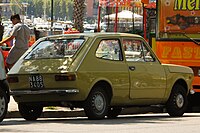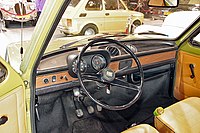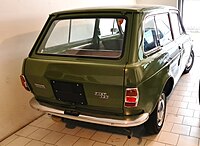
The Fiat 128 is a transverse front-engine, front wheel drive small family car manufactured and marketed by Fiat from 1969 to 1985 as a two- or four-door sedan, three- or five-door station wagon as well as two- or three-door coupé. The 128 running gear and engine, reconfigured for a mid-engined layout, were used in the Fiat X1/9 sports car.

The Volkswagen Polo is a supermini car (B-segment) produced by the German car manufacturer Volkswagen since 1975. It is sold in Europe and other markets worldwide in hatchback, saloon, and estate variants throughout its production run.

The Fiat Uno is a supermini manufactured and marketed by Fiat. Launched in 1983, the Uno was produced over a single generation in three and five-door hatchback body styles until 1995 in Europe — and until 1 January 2014, in Brazil. Designed by Giorgetto Giugiaro of Italdesign, the Uno strongly recalled the high-roof, up-right packaging of Giugiaro's 1978 Lancia Megagamma concept, in a smaller configuration.
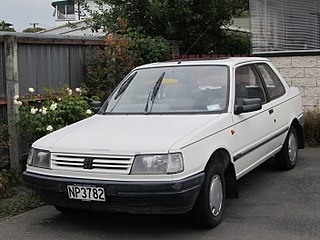
The Peugeot 309 is a small family car that was manufactured between 1985 and 1994 in France, England and Spain by PSA Peugeot Citroën. It was originally intended to be badged as a Talbot and, as development progressed, to be called the Talbot Arizona.
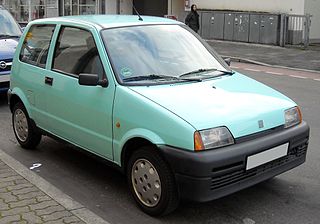
The Fiat Cinquecento is a front engine front-wheel-drive, four passenger, three door hatchback city car, manufactured and marketed by Fiat from 1991 to 1998 over a single generation.
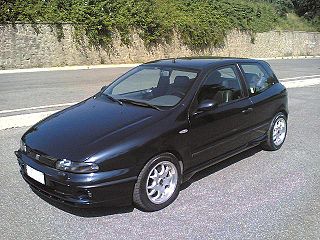
The Fiat Bravo and Fiat Brava are small family cars produced by the Italian automaker Fiat from 1995 to 2003. They were effectively two versions of the same car: the Bravo, a three-door hatchback, and the Brava, a five-door fastback. The Bravo name was revived in January 2007, with the all-new Fiat Bravo, a replacement for the Stilo. The new version was available only with five doors.

The Fiat Stilo is a small family car available as a three- and a five-door hatchback, as well as an estate, produced by Italian automaker Fiat. The Stilo hatchbacks were presented in March 2001 at the Bologna Motor Show, and launched on European market in October 2001 to replace the Fiat Bravo/Brava, with the Stilo Multi Wagon following in January 2003.

The Fiat Ritmo is a small, front-engine, front-wheel drive family car manufactured and marketed by Fiat, launched in April 1978 at the Turin Motor show and offered in 3- and 5-door hatchback and cabriolet body styles – from 1978 to 1988 with two facelifts.

The Audi 50 is a small 'Supermini' car, produced by German automaker Audi from 1974 to 1978, and sold only in Europe. Introduced two and three years after the French Renault 5 and the Italian Fiat 127 respectively, the Audi 50 and its VW Polo twin were seen at the time as Germany's first home-grown entrant in Europe's emerging class of "supermini" hatchbacks, supplanting a generation of small and often rear-engined economy cars.

The Fiat 131 is a family car manufactured and marketed by Fiat from 1974 to 1984 after its debut at the 1974 Turin Motor Show. Available as a two-door and four-door saloon and 5-door estate across a single generation, the 131 succeeded the Fiat 124.

The Fiat 147 was a three-door hatchback subcompact car produced by Fiat in the Brazilian state of Minas Gerais from autumn 1976 until 1987, when it was replaced by the Fiat Uno. It was the Brazilian variant of the Fiat 127. Some were also built by Sevel in Argentina until 1996, and assembly also took place in Colombia, Uruguay, and Venezuela.

The Simca 1100 are a series of French compact family cars – mainly C-segment hatchbacks, but also a compact wagon and popular delivery vans – built for over 15 years by French car-maker Simca, from 1967 through 1982/1985. There was even a very early 'hot hatchback', and a family cross-over: the Matra Simca Rancho. The hatchbacks were replaced by the Simca-Talbot Horizon.
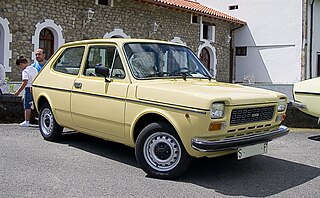
The SEAT 127 is a supermini produced by the Spanish automaker SEAT between the spring of 1972 and 1982, based on the Fiat 127.

The Autobianchi A112 is a supermini produced by the Italian automaker Autobianchi. It was developed using a shrunken version of the contemporary Fiat 128's platform. The mechanicals of the A112 subsequently underpinned the Fiat 127. It was introduced in November 1969, as a replacement for the Bianchina and Primula, and was built until 1986, when it made way for the more modern Autobianchi Y10. Over 1.2 million A112s were produced in Autobianchi's Milan factory.

The Fiat Fiorino is a small commercial vehicle produced by the Italian car manufacturer Fiat since 1977. Its first two generations have been the panel van derivatives of other small models, such as the Fiat 127 and Fiat Uno, while the current third generation was developed jointly with PSA Peugeot Citroën, and is based on the Fiat Small platform.

The Datsun Cherry (チェリー), known later as the Nissan Cherry, was a series of subcompact cars which formed Nissan's first front-wheel drive supermini model line.

The Volkswagen Polo Mk3 is the third generation of the Volkswagen Polo supermini car and was produced from 1994 until 2002, with a facelift at the end of 1999. It was available in hatchback, sedan and wagon body styles. Although the Polo Mk3 hatchback didn't share the same platform as the Seat Ibiza, saloon and estate models were rebadged as Seat Córdoba.

In 2015 Spain produced 2.7 million cars which made it the 8th largest automobile producer country in the world and the 2nd largest car manufacturer in Europe after Germany a position in the ranking that it was still keeping in 2024. Approximately 80% of that production is for export. During the first half of 2016, with exports valued over 24 billion euros over that period, the automotive industry accounted for 18.9% of the total Spanish exports.

The Opel Corsa is a supermini car engineered and produced by the German automobile manufacturer Opel since 1982. Throughout its existence, it has been sold under a variety of other brands owned by General Motors and also spawned various other derivatives.
Designed by Aurelio Lampredi, the Fiasa engine first appeared in the Brazilian-built Fiat 147 in September 1976. The name Fiasa is a portmanteau of "Fiat Automóveis S.A.", for whom it was developed. The in-line four-cylinder engine has five main bearings, a cast iron block with an aluminium cylinder-head with belt-driven overhead camshafts actuating the valves. The engine remained in production until 2001 in Latin America, and also provided the basis for a diesel version. The capacity was initially 1.0 L (1,049 cc), but Lampredi designed the engine to be suited for a considerably longer stroke. Sizes eventually ranged between 1.0 and 1.5 L. The last versions of this engine to be built was a 1.5-litre, dedicated-ethanol version developed in Brazil that served the Fiat Uno and its derivatives, and later yet the Fiat Palio until 2001.



